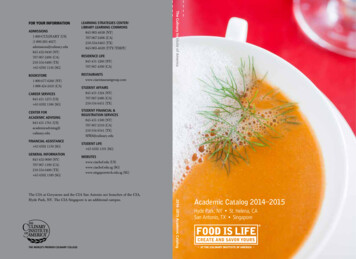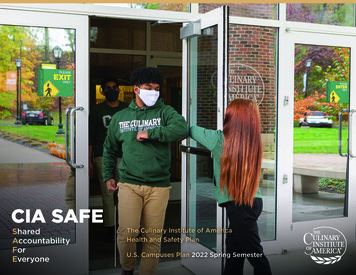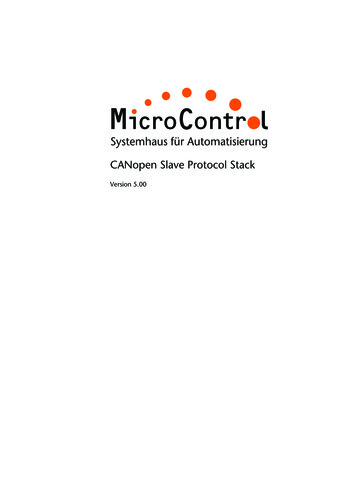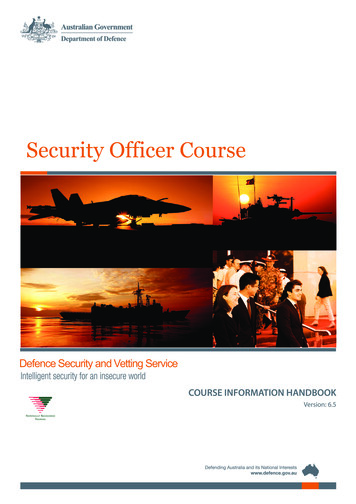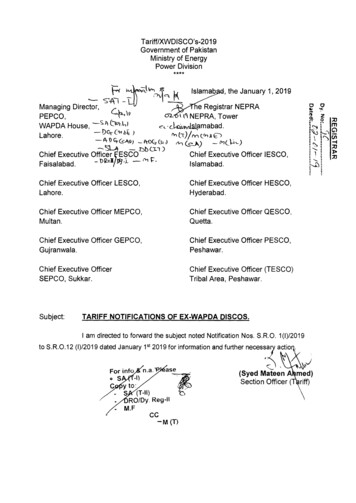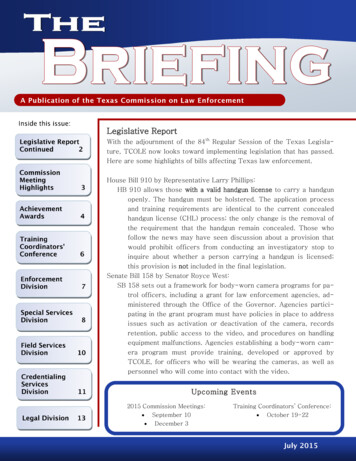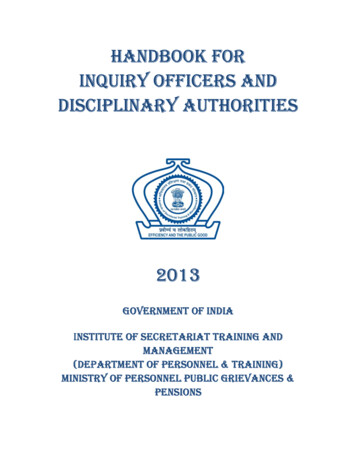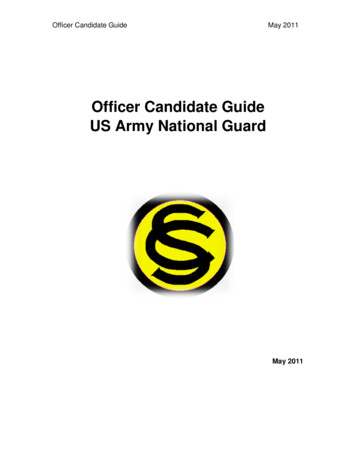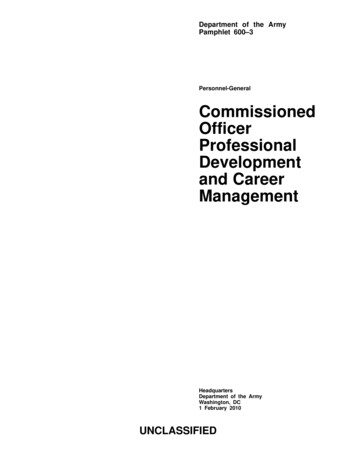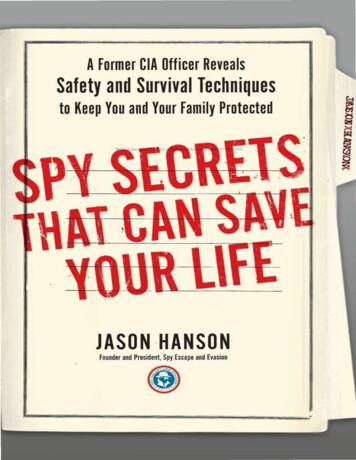
Transcription
A Former CIA Officer RevealsSafety and Survival Techniques1to Keep You and Your Family Protected,PV SECRETSHATCAHSlWEJASON HANSONFounder and President. Spy Escape and Evasion9.Ig
Advance Praise forSPY SECRETS THAT CAN SAVE YOUR LIFE“Jason Hanson is a powerful proponent and practitioner of personal defense tools andtechniques, all designed to protect you and your family in your daily lives, at home, and evenwhile traveling. The valuable information and insights in this book, the same material hedelivers in classes all over the country, could save your life.”—Peter Earnest, director of the International Spy Museum and former CIAClandestine Service Officer“When I first met Jason Hanson while he was pitching me his business on Shark Tank, I knewthat his company was going to be a winner—and more importantly that I might learn some tipsthat could one day save my life!”—Daymond John, star of ABC’s Shark Tank“You probably have heard me say before that if I wasn’t a cook, I would have loved to be a spy!Jason Hanson lets us all be secret agents by giving us the 411 on how to get out of potential 911situations. With his inner secrets of the CIA, he can show you tips and tricks that could save youand your family’s lives!”—Rachael Ray“The secrets Jason reveals in this book have literally saved my life. I used what Jason taught meto escape a potential kidnapping and an attack. I’ll be forever grateful for the techniques heshared with me.”—Heather O’Brien Walker, motivational speaker and life coach“‘Trade craft’ refers to a functional yet mythical set of skills every warrior, operator, oroperative hopes to develop and master as they execute the duties of their trade; Jason Hansonhas forgotten more trade craft than most will ever know. I have read many books and manualsfocused on teaching and explaining these skill sets, but few hit the mark as cleanly, aseffectively, and as easily digestible as Spy Secrets That Can Save Your Life. This book isoverflowing with practical knowledge and teaching points that can and will save your life. NavySEALs study all of the elements from this book, but I was stunned to glean so many secrets ofthe trade that will now join my bag of tricks on and off the battlefield.”—Rorke Denver, Navy SEAL and New York Times bestselling author of Damn Few
ContentsAdvance Praise for Spy Secrets That Can Save Your LifeTitle PageCopyrightIntroduction1 Survival Intelligence2 Situational Awareness: The Single Most Important Thing I Learned in the CIA3 Your Spy Escape and Evasion Kit: Crucial Items and Information for SurvivingDisasters Both Major and Minor4 Become an Escape Artist: How to Easily Escape Rope, Handcuffs, Zip Ties, andDuct Tape5 The Impenetrable Home: How to Criminal Proof Your House6 Travel Safety: Staying Safe in Planes, Taxis, and Hotels7 How to Run Countersurveillance Like a Pro8 Social Engineering Secrets9 How to Be a Human Lie Detector10 How to Disappear without a Trace11 The Art of Survival Driving
12 Defending Yourself: Weapons and Important Self-Defense TacticsAcknowledgmentsReferencesIndexAbout the Author
IntroductionPeople often ask me why I joined the CIA. The truth is, when you take a look at my childhood itmakes perfect sense. When others were picking up girls, I was running around in the woodswith a BB gun (or building a potato launcher out of PVC pipe). I also spent lots of time in theBoy Scouts and eventually became an Eagle Scout. If it had to do with adventure, survival, orbeing prepared, I was drawn to it. As I grew older, I realized I never wanted a normal desk job,and my first job out of college was as a police officer. Soon after, both the Secret Service andthe CIA offered me a job. I figured the CIA would be more exciting so I accepted their offer.When I joined the CIA in 2003, I never imagined that these same tactics I used as a CIAofficer for counterintelligence, surveillance, and protecting agency personnel could be sohelpful in everyday civilian life. Because of my top-level training, I am blessed to have manyunique skills. I can escape from handcuffs within seconds, pick a lock with ease, hotwire a car,use social engineering to get what I want, and know when someone is telling a lie. I canimprovise a weapon, pack a perfect emergency kit, and even disappear off the grid if I need to. Ican also determine if I’m being followed, deescalate potentially dangerous encounters withwould-be attackers, and keep myself and my family safe, both at home and when traveling.Some of these skills are everyday necessities, while others don’t come into play very often andare intended mostly for your “inner spy.” But all of them can and do save lives. I’d like to sharethese skills with you because, even though I pray you will never find yourself in danger, youmay be the next person saved by this information.Since leaving the CIA to become an entrepreneur and raise a family, it has been my missionto share my life-saving tactics with others. My passion for personal safety and security led meto open my training school, Spy Escape and Evasion, in 2010. After several extremelysuccessful years teaching these techniques to thousands of people all around the world,including CEOs, celebrities, security specialists, high-net-worth individuals, stay-at-homemoms, and college students, I realized it was time to share this information with as many peopleas possible who are interested in keeping themselves and their families safe. It is my hope thatSpy Secrets That Can Save Your Life will show you that you don’t have to be an intelligenceofficer to remain safe in an uncertain world. I have successfully taught my spy escape andevasion techniques to thousands of people through my fun and intensive training courses. MySpy Secrets have helped regular, everyday people thwart kidnappings, stop home invasions,prevent muggings, and avoid carjackings. Here are just a few ways these methods have savedlives:
Amy O. from Virginia knew immediately how to handle herself when sherealized she was being followed on a running trail near her home.Jared L. from Las Vegas knew exactly what to do when he was threatened inan elevator in a parking garage.Dan P. from Los Angeles shared that after taking my class he was able toavoid harm when an angry and threatening man approached his car near theairport.Gary S., the vice president of a manufacturing company, who travels elevenmonths out of the year, avoided two separate mugging attempts in China.Heather M. from Sarasota, Florida, was able to escape using her tactical penwhen two men tried to kidnap her at a gas station.Dennis R. from Texas was able to survive a violent home invasion by usingthe tactics taught in my Spy Escape and Evasion course.These individuals survived potentially dangerous or even life-threatening situations becausethey knew exactly what to do. They reacted using the various tactics from my courses andavoided becoming victims of violent crimes. It is my goal that after reading this book that youwill be empowered and confident, knowing how to respond in any crisis or emergency situationyou or your loved ones might face.
1SURVIVAL INTELLIGENCEYou’re about to acquire some exciting new skills. After reading this book, you’ll know how toescape quickly out of duct tape and rope and will know how to tell if someone is lying to you ortrying to social engineer you into an unwelcome situation. That being said, the skills you’reabout to learn need to be accompanied by something equally important—what I call survivalintelligence. In short, survival intelligence involves having the confidence to know that you canrespond appropriately in any emergency situation. You can react quickly and smartly during acrisis using the tools you have on hand. You’re prepared and know you can provide for yourfamily’s safety. Because I feel survival intelligence is as important as the skills I’m about toteach you, I’ve created seven easy-to-follow rules to help you achieve and maintain it.Following these rules will put you in the best position possible to protect yourself and yourfamily.Throughout the book, you’ll be reminded of the importance of these rules, and it’s my beliefthat actively following them can mean the difference between staying safe and facing a tragedy.You’ll also note that I’ve used stories from all over the world to demonstrate how my varioustactics can be used. While reading about tragedies or near tragedies that have taken place, youmay find yourself wondering, “What were they thinking?” Or “How did they not see thatcoming?” It’s my hope that by following a few critical rules, you and your family will never bein a position where you’re asking yourself, “How did we not see that?” but will instead beempowered to act quickly and appropriately in any dangerous situation that comes your way.
Rule 1: Practice AdaptabilityLife is rarely completely cut and dry. My intelligence training has taught me that while knowingwhat to do in emergency situations is important, ultimately it’s being adaptable that can saveyou. As you learn various skills throughout the book, keep in mind that it’s your ability to putthem into practice in unexpected situations that can make the biggest difference. Life doesn’talways go as planned, and it’s crucial to be ready to tackle what it throws at you with the toolsyou have on hand. The best part about this rule is that it isn’t hard to practice. You’ll see thatwhile being a fast, strong, powerful person is great, there’s a limit to how helpful this can be ifyou’re unable to adapt to a new and potentially threatening situation. Make a point ofcultivating adaptability whenever you can.
Rule 2: Be Self-ReliantI’m a big believer in self-reliance. I simply don’t want to depend on someone else to take careof my family or myself. I think self-reliance and personal responsibility are to be valued. Thisgoes beyond personal philosophy. Throughout the course of this book you’re going to bereading about some situations that ended tragically, and unnecessarily so, often due, at least inpart, to a lack of self-reliance. It is my hope that everyone who reads this book will see theimportance of being able to act for himself or herself in an emergency situation. I believe it iscrucial to have both the tools on hand and the ability to act to save yourself if necessary. Ourcountry has faced some challenging times that have tested the self-reliance of many people. Forexample, terrorist attacks and natural disasters have resulted in many people realizing they mustfend for themselves in the aftermath of a crisis. As you’ll see in this book, some people weremore prepared to do this than others.Self-Reliance Helping OthersMake no mistake. While I believe self-reliance is a key trait when it comes to survival, there’sanother reason it’s valuable. When we learn to be self-reliant, we put ourselves in a position tohelp others. It is my hope that after reading this book, the skills I’m going to teach youcombined with a strong sense of self-reliance will put you in a stronger position to be useful toothers in an emergency situation.
Rule 3: Don’t Be a HeroLet me be clear. The rule about not being a hero isn’t about not taking action and isn’t about notbeing a valued, helpful member of society. This rule is about being a bigger person and havingthe good sense to walk away from a potential confrontation—even if there is a part of you thatdoesn’t want to. Trust me, I know how hard this can be. I was running early one morning inBaltimore, Maryland, toward the inner harbor. I noticed two guys on the sidewalk ahead of me.I was in my jogging clothes, and they were fully dressed walking around at 6 a.m., which is abit unusual. As I ran toward them, I saw them look at each other and then spread apart, creatinga situation in which I’d have to run between the two of them. Once I was between them, whoknows what they were going to do. I decided to play it safe: run across the street, making sure togive them eye contact and let them know I’m paying attention. Maybe it was nothing. Maybethey had six friends around the corner and they were going to rob me. My main point is that Ididn’t let my ego get in the way; I didn’t feel a need to prove myself by running between them(although you’ll soon learn why my decision to give them eye contact was important) and risk apotentially dangerous situation.In another instance, a drunken idiot came out of a gas station and gave me the bird andstarted telling me off. Turns out, he thought I was someone he knew who had the same car. Myresponse? “No problem. Don’t worry about it.” I might have wanted to tell this guy off, but Ihave the sense to know that it’s simply not worth it.I can tell you that the toughest, most highly skilled guys I met while in the CIA were also thequietest. They were confident in their abilities and didn’t need to go around boasting about theirskills. I’m smart enough to know that it’s best to avoid escalation. I don’t need to put myself atrisk of meeting that one guy who has better skills than I do or someone who happens to getlucky that day. Feel empowered by the skills you have, and the ones I’m going to teach you, butbe smart about when you use them.
Rule 4: Movement Saves LivesThis is not the only time you’re going to hear me say this: Movement saves lives. As you readabout various situations people have been faced with throughout the book, you’ll see that it’sthose who move are the ones who survive. This is also known as getting off of the X. Theconcept works in a couple of ways, and I’ll outline how to handle various scenarios in greaterdetail in later chapters. To give you the basic idea, think about it this way. If someone comes atyou with a knife, you have a couple of immediate choices—you can move out of the way or youcan get stabbed. I’m obviously simplifying the situation, but I want you to see that movingwhen threatened needs to be your first priority. This concept works in other ways too—forexample, you may be surprised to learn that many people often survive the impact of a planecrash, but then die from inhaling the toxic smoke. Some people are so shocked by the crash thatthey can’t even manage to unbuckle their seat belts, and they die as a result. The people whoaren’t killed on impact and make it out alive are the ones who get out of their seats and move.They don’t freeze. They unbuckle their seat belts and quickly get themselves out of danger. Yousimply want to remember that in any threatening situation—whether it’s a hurricane, a planecrash, or terrorist attack—movement saves lives.
Rule 5: Perception Is EverythingOne of the best things about sharing my spy secrets is that some of them are so simple and easyto execute that you can basically put the book down and make a potentially life-saving changein just seconds. This is because perception is important, and I’m going to teach you about thevarious actions you can take to give off a particular perception—whether it’s that you’re not aperson to be messed with and criminals should stay away or that your house is the one house onthe block that a criminal shouldn’t dare try to rob. To properly execute the physical andpsychological tricks I’m going to show you in this book, you need to start being aware of theperceptions both you and others give off. Ask yourself the following questions: Do I look like aperson who would be an easy victim? Does my house appear uninhabited? Am I walking withconfidence? What about those around you? Is the person sitting next to you in a restaurantacting suspiciously? Are you being followed by the man who you just passed in the grocerystore? Learning to be aware of perceptions can play a key role in remaining safe.
Rule 6: Notice BaselinesBeing aware of baselines, or what’s normal, is a key concept in most intelligence work. Yousimply can’t know if you’re about to walk into an unsafe situation unless you’re familiar withwhat’s normal for a particular place. Is this street always so crowded? Is the noise level I’mhearing normal? Or has something happened? If you’re not acutely familiar with the baseline ofyour home, your neighborhood, and your place of employment, you will not be properlyequipped to know if you are about to be in harm’s way and need to take immediate action.Being able to establish a baseline is a key component for any intelligence work, and I’m goingto show how to do this in detail.
Rule 7: Practice Situational Awareness at All TimesThis final rule is the cornerstone of my philosophy. No amount of training can keep you safe ifyou do not practice situational awareness. I feel so strongly about this that I dedicated an entirechapter of this book to practicing situational awareness, and I maintain that my ability to remainsituationally aware is the most important thing I learned while in the CIA. The bottom line isthat that nothing I teach you can keep you safe if you’re not aware of what’s happening aroundyou. If your nose is buried in your smartphone or you’re having a distracting conversation whilewalking down the street, my tactics for knowing if you’re being followed, for example, aren’tgoing to work. Again, you’re going to be reading about some senseless tragedies that couldhave been prevented if situational awareness had been practiced. You’ll see that I’m notpromoting paranoia—just a healthy sense of what’s happening around you. Situationalawareness is what enables you to get off the X before you’re attacked or to cross the streetbefore you’re mugged. It takes practice and some dedication, but it’s doable, and it may saveyour life.
A Safer, Happier LifeMy mission in writing Spy Secrets That Can Save Your Life and starting the Spy Escape andEvasion training school is to help people live a safer and happier life. These seven rules we’vejust touched upon, combined with the arsenal of self-defense tactics you’re about to learn, willhelp quell your anxiety. We’re living in frightening and unpredictable times, but I believe youshould not live in fear. Knowledge, skill, and awareness will give you peace of mind that youcan handle any event that might arise.
2SITUATIONAL AWARENESSThe Single Most Important Thing I Learned in theCIAAt an upscale Mexican restaurant in Manhattan, workers quickly hid when masked men, one inpossession of a machete, robbed the restaurant. One customer at the bar remained completelyoblivious to the robbery that was taking place, essentially right in front of him. While therobbers searched behind the bar for cash, this person not only continued to look at his phone,but raised his glass in a manner that indicated he’d like another drink. While he missed theentire robbery, he did actually move over to the next bar stool to make room for one of therobbers to escape. The man later told the detectives that he “did not know what had happened”and had been “staring at his phone the entire time.” Managing to miss a robbery that’shappening right around you shows an amazing lack of what’s known as situational awareness.People are often surprised when I tell them the most important thing I learned in the CIA issituational awareness. CIA officers receive the best possible self-defense training in how toward off any kind of attack, how to escape restraints in seconds, and what to do in a car chase—but ultimately it’s situational awareness that’s going to keep an officer alive. We also know thatit’s best to completely avoid any kind of violent confrontation. It’s our knowledge of situationalawareness that allows us to act before a crisis occurs. If guns are drawn, it’s because we missedsomething, and our situational awareness was lacking.I’ve also experienced firsthand how important this skill is as a civilian. I met my wife whileshe was in law school in Baltimore. Her school was in a transitional area. While it wasn’textremely dangerous, it was on the sketchy side, and someone had recently been stabbed on abridge near the school. I didn’t want her walking around alone after night classes, and I alwaysmade a point of picking her up. But it turns out that we encountered trouble in broad daylight. Itwas a gorgeous fall day, so I decided to meet my wife and take her to lunch in Baltimore’s innerharbor. Right on the water, the inner harbor is full of shops and restaurants, and it’s one of thenicer spots the city has to offer. As we were walking to the inner harbor, I noticed a manbehaving very suspiciously. He had crossed the street in front of us several times, and he wasgiving me a ton of eye contact, really staring me down. The man settled about two feet away
from where I was standing. While my wife and I were waiting for the walk signal so that wecould cross the street, he stood directly to my left. Because he was giving me so much eyecontact, I was watching him in my peripheral vision, and paying a lot of attention to what hewas doing. I made a point of watching his hands. It’s hands that kill—hands reach for knives orguns and throw punches. When the light turned, I purposely started taking small steps. I noticedthat the guy was pacing me, walking step for step with me. At this point I had my tactical penout. After about three steps, I turned to him and I said, “Excuse me, do you know what time itis?” He looked at me funny, and I said again, “Excuse me, do you know what time it is?” Heresponded, “Four-thirty.” We stared at each other for about a second, but it felt like an eternity.Suddenly he turned around and quickly walked away. He crossed the street and I never saw himagain.By asking him what time it was, I accomplished two things. First, I had completely removedthe element of surprise. My hands were up, so if necessary I could strike or disarm him.Secondly, I know that a normal reaction time is approximately one and a half seconds. That’show long, at minimum, it takes a person to react to a situation. I knew that if he attacked, I’dneed one and half seconds to do what was necessary to protect myself and my wife. The guyproceeded to tell me the time and immediately turned around and walked the other way (the factthat he then changed direction is a sure sign he was planning to do something). If this guy wereinnocent, he would have kept walking to the inner harbor like he was originally.Criminals don’t want their targets to know they’re onto them, but I knew. And by indicatingto him that I knew what was going on, he made a choice to move on. Practicing situationalawareness put me in a position to know that something was off. By being alert to mysurroundings, I was able to identify that my wife and I were in harm’s way, and I was able totake action. While there are many ways this situation could have been defused, the importantthing was that I did something. I trusted my gut and reacted. Had I been paying attention to mycell phone instead of what was happening around me, I would have ended up in an altercationwith a mugger.
What Is Situational Awareness?If you take a look at what most people are doing on the street, at a playground, or a shoppingmall, you’re going to see one common factor. The majority of people are either talking on theirphones, or sending and reading text messages. If you are looking at your phone, you have yourhead down, you’re disengaged, and you likely have no idea what’s actually going on aroundyou. Or maybe you’re not talking on your cell phone, but you’re preoccupied by work, stress, orjust daydreaming about an upcoming vacation. The bottom line is that if you’re not alert andaware, you are vulnerable. There are many situations in which injury (or worse) could havebeen avoided if people were practicing situational awareness. In San Francisco, there was a rashof cell phone users being assaulted and robbed in public. A forty-three-year-old man waspunched and robbed while texting in broad daylight on a crowded street corner. An up-andcoming comedian in New York fell onto the subway tracks while texting and was struck by atrain. Miraculously she survived. A fifteen-year-old girl in the San Diego area was lessfortunate. She was standing on a street corner texting when she attempted to cross against thelight. Her brother tried to stop her, but he was too late. She stepped into the path of an oncomingtruck and was killed. Had any of these individuals been paying attention to their immediatesurroundings, these tragic situations would have been avoided.Smartphones and Situational AwarenessI realize this might sound weird, but I’ve never sent a text message in my entire life, and Ihave no plans to. While smartphones may have some great features, I think they areterrible for situational awareness. How many times have you been stopped at a green lightand the guy in front of you was too busy texting to notice the light was now green? Thebottom line is that none of my training as a CIA officer is going to help me if I’m too busytexting to notice I’m in danger. There are other reasons I stick to a flip phone—smartphones store too much personal information, and they can suck up too much time—but the main reason is that smartphones are simply a threat to my situational awareness.
The Most Important Colors: White, Yellow, Orange, andRedAt its most basic, situational awareness is about remaining alert and knowing what’s going onaround you. It’s really about being able to assess your environment, anticipating danger, andbeing ready to take any further action if necessary. What I recommend following, and what Iteach in my Spy Escape and Evasion courses, are the Cooper Color Codes. These are four stagesof readiness that enable a person to be in a mind-set to react appropriately and quickly to athreat.Jeff Cooper was a Marine who served in the Pacific on the USS Pennsylvania during WorldWar II. Cooper returned to active duty during the Korean War, where he was promoted tolieutenant colonel. In the 1970s, Cooper founded the American Pistol Institute in Arizona,where he taught handgun and rifle classes to civilians as well as law enforcement and militarypersonnel. While Cooper was known for his handgun and firearm expertise, he also believedthat actual weapons or self-defense skills did not provide the best way to survive a potentiallyfatal attack. Cooper believed that the most effective tool was a person’s mind-set. Cooper’sColor Codes are used to describe different degrees of situational awareness, as follows:Condition White: Unprepared and totally unaware. The individuals Idescribed earlier in this chapter would have been operating under ConditionWhite. It is crucial that you learn to avoid this condition at all times.What it looks like: Head down, eyes averted, oblivious to what’s going onaround you. A person in Condition White may be daydreaming, talking on acell phone, texting, or engaged in a conversation. If you’re in ConditionWhite you may be sitting on a bench reading or you might walk into a darkalleyway at night without thinking twice about it, putting yourself in aposition where you could easily be attacked. If you aren’t alert to what’shappening in your immediate environment, you are vulnerable andunprepared for whatever might happen next.Condition Yellow: Relaxed alert. When you are in Condition Yellow, there’sno specific threat, but you remain alert and aware. Condition Yellow isn’tabout expecting an attack but about allowing yourself to be constantly takingin information about what’s going on around you. People functioning inCondition Yellow are difficult to surprise. This is how most people operatedbefore cell phones.What it looks like: Your head is up, you’re aware of your surroundings. You
may be having a conversation, but aren’t so distracted that you wouldn’tnotice a car coming your way, or a person heading toward you with intent toattack. A person in Condition Yellow would definitely notice a strangeperson approaching him on the street, and would have ample time to decidehow to respond—by crossing the street, changing direction, calling for help,and so on. Condition Yellow allows you to notice if trouble is coming yourway. It’s important to remember that staying in condition yellow keeps youout of Condition Red, which I’ll get to in a minute. Being in ConditionYellow while walking with my wife in Baltimore City is what kept us fromgetting mugged, and it can help you stay safe too.Condition Orange: A state in which there is a specific alert. You may noticea man in a thick winter coat walking around a crowded building in themiddle of August. You may be walking to the parking lot when you noticesomeone paying too much attention to you. Something about a situation oran individual feels potentially threatening. You prepare yourself by puttingyour hand on your tactical pen or you get out your cell phone to call for help.What it looks like: I immediately went into Condition Orange when my wifeand I were standing on the street next to the person I believed was going toharm us. I was in Condition Yellow (aware) when I noticed something offabout this particular person. Once in Condition Orange, I got out my tacticalpen. (I always carry a gun where I legally can, but I don’t have a concealedcarry permit for the state of Maryland. I’ll get to the benefits of carrying atactical pen shortly.) I remained alert and was ready to deflect an attack. Ifyou feel a person is following you, turning around and walking into acrowded store is another example of a Condition Orange response.Condition Red: Condition Red is the crisis condition, but you are mentallyprepared to fight or escape. You’ve predetermined what exactly was going tocause you to react, and you’ve now received that specific trigger from thecriminal. You got out your tactical pen while you were still in ConditionOrange, but now you’re striking your attacker with it, fighting for your life.While it’s entirely possible the situation may involve fighting or using aweapon or any self-defense tactics you have, it’s also possible the situationwill be resolved by other me
—Daymond John, star of ABC’s Shark Tank “You probably have heard me say before that if I wasn’t a cook, I would have loved to be a spy! Jason Hanson lets us all be secret agents by giving us the 411 on how to get out of potential 911 situations. With his inner secrets of the CIA, he can show you tips and tricks that could save you
